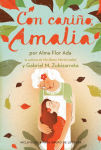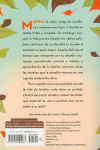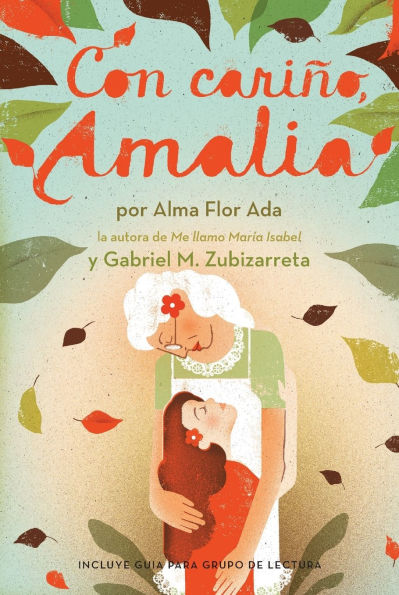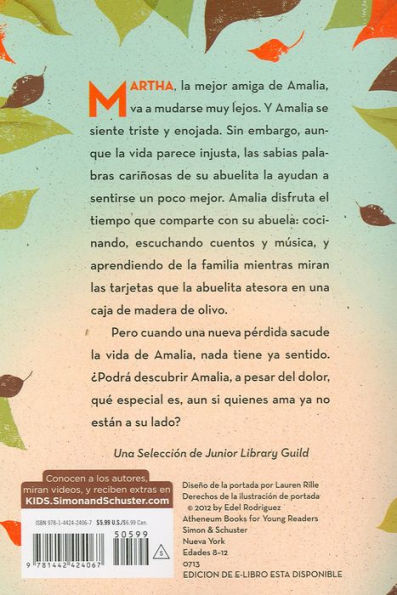Pero cuando una nueva pérdida sacude la vida de Amalia, nada tiene ya sentido. ¿Podrá descubrir Amalia, a pesar del dolor, que especial es, aun si quienes ama ya no están a su lado?
Pero cuando una nueva pérdida sacude la vida de Amalia, nada tiene ya sentido. ¿Podrá descubrir Amalia, a pesar del dolor, que especial es, aun si quienes ama ya no están a su lado?


Paperback(Reprint)
-
SHIP THIS ITEMIn stock. Ships in 1-2 days.PICK UP IN STORE
Your local store may have stock of this item.
Available within 2 business hours
Related collections and offers
Overview
Pero cuando una nueva pérdida sacude la vida de Amalia, nada tiene ya sentido. ¿Podrá descubrir Amalia, a pesar del dolor, que especial es, aun si quienes ama ya no están a su lado?

Product Details
| ISBN-13: | 9781442424067 |
|---|---|
| Publisher: | Atheneum Books for Young Readers |
| Publication date: | 07/23/2013 |
| Edition description: | Reprint |
| Pages: | 129 |
| Product dimensions: | 5.10(w) x 7.40(h) x 0.50(d) |
| Language: | Spanish |
| Age Range: | 8 - 12 Years |
About the Author
Gabriel M. Zubizarreta draws from his experiences of raising his three wonderful daughters in his writing. He hopes his books will encourage young people to author their own destinies. He coauthored Love, Amalia and Dancing Home with Alma Flor Ada. Gabriel lives in Northern California with his family and invites you to visit his website at GabrielMZubizarreta.com.
Read an Excerpt
1. Melcocha casera
—¿Qué te pasa, Amalia? ¿Qué es lo que te preocupa?
La abuela quitó del fuego la olla en la que había hervido la miel, para que se enfriara un poco. Luego se secó la frente con un pañuelo de papel y miró a su nieta. Por la pequeña ventana sobre el fregadero entraba la luz del atardecer. Los geranios, en varias macetas, añadían una nota de tenue color rosado.
—Estás muy callada, hijita. Dime lo que te preocupa—insistió su abuela—. Se ve que te pasa algo.
—No me pasa nada, abuelita, de verdad, estoy bien. . . .
Amalia trató de usar un tono convincente, pero la abuela continuó:
—¿Es porque Martha no ha venido contigo hoy? ¿Está bien?
Hacía tiempo que Amalia tenía la costumbre de ir a la casa de su abuelita los viernes por la tarde. Durante los dos últimos años, desde que empezaron el cuarto grado, su amiga Martha la acompañaba. A lo largo de la semana Amalia esperaba con ilusión ese momento. Pero hoy era diferente.
Se demoró antes de contestar:
—Ya no va a venir, abuelita. ¡Nunca más!
A pesar de sus esfuerzos, la voz se le quebró y algunas lágrimas se asomaron a sus ojos castaños.
—Pero ¿por qué, hijita? —preguntó su abuela con un tono cálido. La abrazó con cariño y esperó a que su nieta le explicara lo que sucedía.
Amalia sacudió la cabeza con un gesto frecuente en ella cuando estaba cansada. Y el pelo largo le barrió los hombros. Solo entonces respondió:
—Martha se va. Su familia se muda al oeste, a algún sitio en California. ¡Tan lejos de Chicago! Hoy se fue a la casa directamente desde la escuela para empacar. ¡No hay derecho!
—Tiene que ser muy difícil para ti.
Su abuelita había hablado con una voz llena de comprensión, y Amalia suspiró.
Se quedaron en silencio por un momento. La luz del sol, cada vez más tenue, se iba apagando, y la miel, que había hervido por tanto rato, iba enfriándose y convirtiéndose en una masa oscura cuyo aroma llenaba el aire de la cocina.
—¿Qué te parece si estiramos la melcocha? —preguntó la abuela mientras levantaba la vieja olla de bronce y la ponía sobre la mesa de la cocina. Luego echó la pegajosa melcocha en un tazón de porcelana gruesa con un borde amarillo brillante. Amalia había imaginado alguna vez que ese tazón era como un pequeño sol en la cocina. Pero hoy estaba demasiado disgustada y veía apenas una pesada vasija sin asas.
Se lavaron las manos cuidadosamente en el fregadero y se las secaron con un pañito de cocina. Cada paño tenía bordado en punto cruz un día de la semana con un color distinto. Y su abuela siempre elegía el del día correspondiente. En el que estaban usando podía leerse VIERNES en un profundo azul marino.
Con esos paños, la abuelita le había enseñado los días de la semana y el nombre de los colores en español. Con frecuencia Amalia se sorprendía al darse cuenta de todo lo que había aprendido de su abuela.
Cuando se hubieron secado las manos, se las untaron de mantequilla para impedir que la melcocha se les pegara en los dedos o les quemara la piel. Con una cuchara grande de madera, la abuela echó una porción para cada una de la melcocha que se enfriaba en el tazón.
A medida que la estiraban y la amasaban una y otra vez, la melcocha fue aclarándose y volviéndose más ligera. Entonces empezaron a hacer rollitos de color ámbar y los ponían en trozos de papel encerado. ¡Qué cambios podían producirse en los ingredientes al cocinarlos!
Amalia había ayudado a estirar la melcocha muchas veces, pero nunca dejaba de maravillarla cómo cambiaba de color con solo estirarla y amasarla y estirarla de nuevo. Iba de marrón oscuro a un tono rubio, como el color del pelo de Martha.
El recuerdo de Martha la hizo fruncir el ceño. Pero si su abuela lo notó, no hizo ningún comentario. En cambio, le dijo:
—Lávate bien las manos. Vamos a sentarnos un ratito mientras la melcocha se enfría.
Antes de lavarse las manos, Amalia se chupó los dedos. Nada era tan rico como «limpiarse» después de cocinar. La mantequilla mezclada con la melcocha formaba un caramelo que sabía tan bien como la masa que «se limpiaban» con Martha cuando horneaban galletitas en la casa de su amiga.
Una vez que se hubo lavado y secado las manos, Amalia fue con su abuelita a la sala. Se sentaron en un sofá de tapiz floreado que alegraba la habitación como si un trozo del jardín estuviera dentro de la casa. A la abuelita le encantaban los colores de la naturaleza, como podía verse en cada uno de los rincones de su hogar.
—Sé lo difícil que es aceptar que una persona querida se marche . . . Primero uno se enfada, luego se pone triste, y después parece tan imposible que uno desea negarlo. Pero cuando se hace evidente que es verdad, regresan la rabia y la tristeza, a veces más dolorosas todavía que antes. . . . Lo he vivido ya varias veces.
Amalia escuchó con atención, tratando de adivinar a quién se refería su abuela. ¿Estaba pensando en sus dos hijos, que vivían tan lejos?, ¿o en la hija, que siempre prometía venir a Chicago desde la ciudad de México a visitarla y nunca lo hacía?, ¿o se estaba refiriendo a su esposo, que había muerto cuando Amalia era tan pequeña que no se acordaba de él?
—Pero se encuentra el modo de mantenerlos cerca, Amalia.
Sonriendo, como si se le acabara de ocurrir algo, añadió:
—Ven, acompáñame.
Se levantó y le indicó que la siguiera al comedor.
Lo único que Amalia quería era acabar la conversación. Ya era terrible que Martha le hubiera dicho que le tenía una sorpresa, y luego resultara que la sorpresa era que estaba a punto de mudarse lejísimo. La ida de Martha parecía tan definitiva y permanente que Amalia odiaba siquiera imaginarlo. Y hablar de ello solo la hacía sentirse peor. ¡Cómo hubiera querido no tener que esperar a que su padre fuera a buscarla y poder irse a su casa! Quizá entonces podría llamar a Martha y oírla decir que todo había sido un gran error y que, en realidad, no se estaba mudando. Y todo desaparecería como se esfuman las pesadillas al despertar.
What People are Saying About This
“Ada and Zubizarreta (Dancing Home, 2011) reunite to focus on a young Latina girl coping with loss…. The authors tackle issues of love, loss and familial ties with a sympathetic, light hand and blend Spanish words and Latino music and recipes into Amalia’s tale. A charming story, especially for children facing the loss of grandparents.”
—Kirkus Reviews, June 1, 2012
“With sensitively drawn characters and a low-key story moving between present and past, the authors construct a portrait of a multigenerational immigrant family. The Latino culture of the family is reflected in the cooking the two do together, the memories Abuelita passes on, and all the letters she has kept from distant loved ones.”
—Horn Book Magazine, July/August 2012
“Ada and Zubizaretta’s (Dancing Home)…collaboration focuses on the deep bond between Mexican-American sixth-grader Amalia and her grandmother…. The authors successfully depict family love and closeness across generations and distances…. In the final chapters…the book…takes on an authentic emotional poignancy, bringing a closing richness to this story of a girl’s first experience of loss.”
—Publishers Weekly, May 28, 2012
“Amalia is upset when her best friend announces that she is moving from Chicago to California. When Martha leaves, Amalia turns to her grandmother for comfort. It is in her kitchen and at her table that the child learns not only about her family and her Mexican heritage, but also about herself…. This story utilizes a special intergenerational relationship to introduce Mexican culture and traditions within the themes of changing family and friendships. Spanish words and phrases are woven into the text…this quiet story may provide a different perspective on the loss of a loved one.”
—School Library Journal, August 2012
“Latina sixth-grader Amalia is so upset by her best friend Martha’s move from their Chicago neighborhood to California that she can’t even say good-bye. When her beloved abuelita passes away suddenly a few days later, she doesn’t even have the chance to say good-bye….Sprinkled with Spanish words and phrases, this quiet story charmingly emphasizes the importance of both friendship and intergenerational relationships. It concludes with simple recipes for making some of Abuelita’s favorite desserts.”
—Booklist, August 1, 2012
Reading Group Guide
A Reading Group Guide for Love, Amalia (Con cariño, Amalia) By Alma Flor Ada and Gabriel M. Zubizarreta About the Book Amalia’s best friend, Martha, is moving away, and Amalia is feeling sad and angry. And yet, even when life seems unfair, the loving, wise words of Amalia’s abuelita have a way of making everything a little bit brighter. Amalia finds great comfort in times shared with her grandmother: cooking, listening to stories and music, learning, and looking through her treasured box of family cards. But when another loss racks Amalia’s life, nothing makes sense anymore. In her sorrow, will Amalia realize just how special she is, even when the ones she loves are no longer near? From leading voices in Hispanic literature, this thoughtful and touching depiction of one girl’s transition through loss and love is available in both English and Spanish. Discussion Questions 1. As the novel opens, Amalia’s abuelita tells her, “You are too quiet, hijita. Tell me what’s bothering you." Consider her grandmother’s ability to detect Amalia’s unhappiness: What can be inferred about their relationship through this interaction? 2. Consider Amalia’s tradition of going to her grandmother’s house each Friday after school. Why does the inclusion of Martha in this ritual make Amalia’s grandmother more sensitive to Amalia’s sense of loss after Martha’s move? 3. Describe Amalia. What makes her a dynamic person? 4. Abuelita tells Amalia, “I know how hard it is when someone you love goes away. One moment you are angry, then you become sad, and then it seems so unbelievable you almost erase it. Then when you realize it is true, the anger and sadness come back all over again, sometimes even more painfully than before." Though she is trying to help Amalia deal with the move of her best friend, in what ways do her grandmother’s words foreshadow the profound loss that Amalia will have to experience? Have you ever had a similar experience where you lost someone with whom you were particularly close? If so, what advice would you give someone dealing with a similar loss? 5. Look at the novel’s cover art. In what ways is the image represented symbolic of the events that transpire throughout the course of the book? 6. Why do you think Amalia chooses not to open the package given to her by Martha? Do you agree with her decision? Why or why not? 7. What does Abuelita’s focus on saving cards and letters from her family indicate about her character? Do you like to collect similar things from others? If so, what does doing so mean to you? 8. How does Martha’s move and Abuelita's death profoundly impact and change Amalia's life? 9. Why does Amalia ultimately choose to tell her grandmother about the theft incident at school before telling her parents? Do you think her grandmother was the best choice? In your opinion, was the principal’s punishment fair? What do you think Amalia ultimately learned from the experience? 10. Though grieving the loss of her grandmother is particularly difficult, Amalia realizes she is luckier than her cousins. How is this so? Have you had an opportunity to become close to a grandparent, or another relative outside of your immediate family? If so, what has made that relationship special to you? 11. After the death of her grandmother, how does Amalia uphold the customs and traditions of her abuelita? What is it about doing so that makes Amalia feel better? Do you have any traditions or customs that your family follows that are linked to family members who have passed away? What is it about preserving these that is so important? 12. Why does being given Abuelita’s olive-wood box serve as a catalyst in changing Amalia’s attitude about Martha’s move and her grandmother’s passing? Do you have a special keepsake that connects you to someone? If so, what is it about that keepsake that makes it so special? 13. Explain the significance of the title, Love, Amalia. In your opinion, does it accurately describe the events and relationships portrayed in the book? 14. Using the phrase, “This is a story about . . .” supply five words to describe Love, Amalia. Explain your choices. Activities and Research 1. Food plays an important role throughout the novel and in Amalia’s relationship with her grandmother. Using the recipes provided at the back of the book, invite a special person in your life to help you prepare one or more of the desserts shared in the book. When finished, take the time to enjoy the company and sweet treats! 2. In our day of e-mails and text messaging, most people no longer write handwritten letters. Consider how Abuelita used her cards to share what others meant to her, and follow her example by creating cards with original art or handwritten letters. Remember, the sentiment (what you are trying to share) is the important part, so be carefree and have fun! 3. In Love, Amalia, part of Amalia’s story focuses on her connection and relationship with her family and the people that matter the most to her. Think about your own special relationships. What makes these individuals so important? Compose a personal journal entry where you share your thoughts, and be sure to answer the following questions: • Who are the individuals who mean the most to you? • Why are these particular relationships so special? • What’s the greatest sacrifice you’ve made for the people you love? • In what ways have the changes you’ve experienced in your life affected those to whom you are closest? Share your writing with the group. 4. Consider the variety of settings for Love, Amalia: Why is each of these places important to Amalia's development? Using the descriptions provided in the book, illustrate the places you believe to be most important to her story. In addition to the illustrations, include a short explanation of the significance of each, and why you believe it is important. 5. Before Martha leaves, she gives Amalia a thick envelope, likely filled with items to help Amalia remember her by. If you were going to assemble a similar package for your closest friend, what would the contents be? Create a list of the items you would put inside for her or him and give a reason why each item would be significant to the two of you. 6. Amalia’s extended family lives in a variety of interesting places throughout the world. Using the library and the internet, do research to learn more about Mexico City, a typical ranch in Mexico, Costa Rica and Puerto Rico. If you had your choice, which would you choose to visit and why? Guide written by Rose Brock, a teacher, school librarian, and doctoral candidate at Texas Woman’s University, specializing in children’s and young adult literature. This guide has been provided by Simon & Schuster for classroom, library, and reading group use. It may be reproduced in its entirety or excerpted for these purposes.



